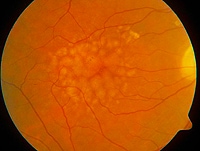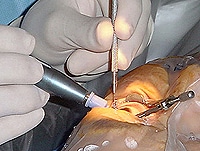Glucosamine supplementation was linked to
significant, reversible increases in intraocular pressure (IOP) in a
small, retrospective study
published online May 23 in
JAMA Ophthalmology.
However, the investigators, led by Ryan K. Murphy, DO, from the
University of New England College of Osteopathic Medicine, Biddeford,
Maine, and colleagues, could not exclude the potential for permanent
damage.
"Frequently, patients are being told that while studies give
conflicting data as to whether glucosamine and chondroitin sulfate are
effective in reducing arthritic pain, there does not appear to be any
risk in trying these supplements," Andrew L. Sherman, MD, professor and
vice chair of clinical rehabilitation medicine at the University of
Miami Leonard M. Miller School of Medicine in Florida, told
Medscape Medical News when asked for comment on the study. "This study, if [the findings are confirmed], attacks that premise."
US prevalence of osteoarthritis is 27 million, and for open-angle
glaucoma, it exceeds 2 million, according to the Centers for Disease
Control and Prevention.
"Although it is [unclear] what the implications of having increased
IOP would be for individual patients, the risk is...that ocular damage
could possibly occur from what were previously thought to be 'benign'
supplements," said Dr. Sherman, who was not involved in the study.
A keen observation by coauthor Edward Hall Jaccoma, MD, clinical
associate professor of ophthalmology at the University of New England
College of Osteopathic Medicine, provided the impetus for this study.
"A family member I was following as a glaucoma suspect suddenly had a
sharp rise in...IOP, and the only change in his life was adding
glucosamine supplements for arthritis," Dr. Jaccoma told
Medscape Medical News.
"I made a tentative connection based on the molecular biology and
potential kinship to steroid glaucoma. When he stopped the supplement,
his IOP returned to baseline levels. Subsequent observations
of...patients on these supplements appear to show an interaction similar
to what [happened] in this index patient."
Study Design and Findings
The investigators retrospectively studied 6 men and 11 women, with a
mean age of 76 years, who had a history of glucosamine supplementation
and ocular hypertension (IOP > 21 mm Hg) or diagnosed open-angle
glaucoma, a willingness to discontinue glucosamine, 3 or more IOP
measurements within 2 years, and no associated changes in glaucoma
medications or eye surgery. Group A (n = 11) had 1 to 3 baseline IOP
measurements before starting glucosamine, and group B (n = 6) had no
baseline IOP measurements.
IOP increased in group A after starting glucosamine supplementation (
P = .001). After glucosamine discontinuation, IOP decreased in group A (
P = .002), group B (
P
= .008), and groups A and B combined (19.5 ± 0.4 to 16.7 ± 3.0 mm Hg in
the right eye and 20.3 ± 2.9 to 17.3 ± 2.4 mm Hg in the left eye;
P < .001). For any categories or comparisons, the left and right eyes in each patient did not differ significantly.
"Many questions are raised by glucosamine supplementation–associated
IOP changes," the study authors write. "This study shows a reversible
effect of those changes, which is reassuring. However, the possibility
that permanent damage can result from prolonged use of glucosamine
supplementation is not eliminated."
Study Limitations and Implications
"Glucosamine supplements are a billion dollar business, and as the
baby boom generation looks for ways to stave off their arthritis, more
and more of them [turn] to what has been billed as a 'safe supplement,' "
said Dr. Jaccoma, who is also director of Southern Maine Eye Associates
in Sanford and of New England Dry Eye Center in Kennebunk, Maine. "My
concern is that some...of them may end up with glaucomatous damage that
could have been prevented or...medicating (or having laser and other
surgical interventions) for a disease...that might have been avoided in
the subset of 'glucosamine responders.' "
Dr. Jaccoma recommends that at the very least, people at risk for
glaucoma have their IOP more closely monitored during glucosamine
supplementation.
"I do have a small subset of patients who find glucosamine so helpful
to their arthritis that they would prefer to treat the IOP [rather
than] give up the supplements," he said. "The large [National Institutes
of Health] study on glucosamine suggested there could be a group of
arthritic patients who do benefit from this supplement, but the majority
did not show much, if any, benefit. Given that data, it appears that
many may be taking this supplement needlessly, if not dangerously."
Study limitations noted by the investigators and Dr. Sherman include
its retrospective design and the very small sample with limited
generalizability because it consisted of patients who were at least
glaucoma suspects. The study did not account for glucosamine dosage,
duration, brand, or compliance.
"[M]y personal observations suggest that the response is very similar
to what we see with steroids, in that the average patient will have
little IOP effect..., but that there is a higher risk group who must be
identified to avoid harm from their steroid treatment," Dr. Jaccoma
said. "I believe...we will find a similar...group that reacts this way
to glucosamine..., but more research is needed."
Coauthor Mona Doss, MA, also from the University of New England
College of Osteopathic Medicine, suggests larger, randomized clinical
trials are needed to assess dose-dependent increase in IOP with
glucosamine supplementation in different patient groups.
"At this point in time more research is required to definitively
change current management," she said. "The clinical implications may
indicate consideration by primary care or other providers in
recommending such supplementation for arthritis in patients with known
risk of elevated IOP or glaucoma."
"These results will need to be replicated in a larger population of
patients to be felt to be entirely reliable," Dr. Sherman concluded.
"{After confirming] these results with a larger study, [they should]
study the real clinical implications of this increase in IOP for...those
with and without glaucoma."
The study authors and Dr. Sherman have disclosed no relevant financial relationships.
JAMA Ophthalmol. Published online May 23, 2013.
Extract









 Patients With Macular Degeneration at Increased Death Risk
Patients With Macular Degeneration at Increased Death Risk Cataract Surgeons See Laser's Potential in a New Light
Cataract Surgeons See Laser's Potential in a New Light FDA Approves Trulign Intraocular Lens
FDA Approves Trulign Intraocular Lens AREDS2: Insights Into Optimal Supplements for AMD
AREDS2: Insights Into Optimal Supplements for AMD